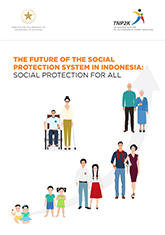The Future of The Social Protection System in Indonesia
Indonesia was among the few countries globally to experience an average growth rate of approximately 7 per cent annually prior to the Asian economic crisis. However, this dropped to approximately 5.6 per cent a year between 2007 and 2016, signaling the need to stimulate the economy, generate demand and increase consumption. Furthermore, while government efforts have had a positive impact in reducing the official poverty rate, the pace of poverty reduction has been slowing down. Even households living above the official poverty line are still subsisting on vulnerable incomes and are still susceptible to falling back into poverty. Household incomes are highly dynamic, as people react to shocks and crises, and respond to opportunities.
Indonesians face a wide range of risks throughout their lives, beginning in the womb and continuing through to their final days. Life-cycle risks and challenges can affect people’s standard of living, particularly when a comprehensive social protection system is not in place.
Through this strategy, TNP2K recommends a social protection system that will protect poor and vulnerable citizens through social safety net schemes designed across the life cycle, as well as prevent health and employment related risks through accessible social insurance schemes. The proposed social protection system will also try to directly address many of the key challenges facing Indonesia and its citizens – particularly stunting in early childhood, low enrolment in secondary level education, disability and old age poverty.
It is recommended that Indonesia gradually move from a social protection system that targets the poorest through social assistance, towards a system that is inclusive of those on middle incomes. Those in the formal sector and those who can pay into the contributory system will receive benefits from social insurance. Progressively, the government should ensure that every citizen is protected, either through contributory or non-contributory schemes.
